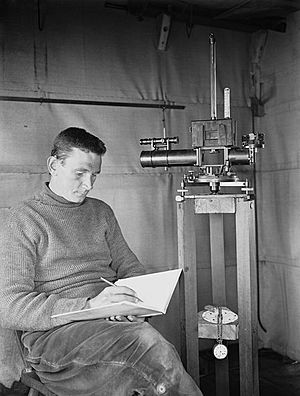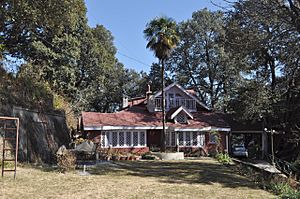George Simpson (meteorologist) facts for kids
Quick facts for kids
Sir George Simpson
|
|
|---|---|

George Simpson making scientific observations in the magnetic hut during the Terra Nova Expedition.
|
|
| Born |
George Clarke Simpson
2 September 1878 |
| Died | 1 January 1965 (aged 86) |
| Awards | The Chree Medal and Prize (1951) Fellow of the Royal Society |
| Scientific career | |
| Fields | Meteorology |
| Institutions | University of Manchester Meteorological Office |
Sir George Clarke Simpson (born September 2, 1878 – died January 1, 1965) was a famous British scientist. He studied the weather, which means he was a meteorologist. He was also the head of the Royal Meteorological Society for a couple of years.
Contents
Early Life and Studies
George Clarke Simpson was born in Derby, England. His father owned a department store.
He went to Derby School and later studied science at the University of Manchester. He also did more studies at the University of Göttingen in Germany.
In 1902, he traveled to Lapland to study atmospheric electricity, which is about how electricity behaves in the air. In 1905, he became the first person to teach meteorology at a British university. This was at the University of Manchester.
Adventures in India and Antarctica
In 1906, George Simpson joined the Indian Meteorological Service. He worked at their main office in Simla, India. He visited many weather stations across India and Burma.
In 1910, he went on an amazing adventure. He and his friend Charles Wright were the weather scientists for Robert Falcon Scott's Antarctic Terra Nova Expedition. The other explorers called him 'Sunny Jim'.
Studying Weather in Antarctica
While in Antarctica, George Simpson built one of the first weather stations ever on the continent. He used balloons to study the atmosphere. This helped him figure out how temperature changes at different heights.
He carefully recorded temperatures and wind speeds at the base camp at Cape Evans. He was in charge of this station for several months. This was when Scott and his team left to try and reach the South Pole in November 1911.
Returning from the Expedition
Simpson came back from Antarctica in August 1912. He returned to Simla, India, to work for the Indian Meteorological Services again.
He lived in a place called Khud Cottage in Simla. Here, he put together all the notes he had made during the Antarctic trip. It was also here that he learned about the sad news of Scott and his team dying on their way back from the South Pole. This made him very sad.
Today, Khud Cottage belongs to the family of Rajeev Madan. During the Second World War, it was even home to the Governor of Burma.
Working During Wartime
When the First World War started in 1914, many people from the Indian Meteorologist Department had to join the army. George Simpson became a weather adviser for the British army in Mesopotamia (now part of Iraq).
Later, he worked for the Board of Munitions, which made weapons and supplies for the war.
Leading the Met Office
In 1920, he became the Director of the Met Office in London. The Met Office is the UK's national weather service. He was the longest-serving Director, staying until 1938.
During his time as Director, he studied many things. These included atmospheric electricity, radioactivity, and how much energy the sun sends to Earth. He also looked into what causes lightning.
The Simpson Wind Force Scale
In 1926, he created the Simpson wind force scale. This was an improved version of the Beaufort scale, which measures wind speed. His scale is still used around the world today, and it's now known as the Beaufort wind force scale.
King George V made him a knight in 1935. This means he was given the title "Sir."
When the Second World War began in 1939, Sir George was called back to work. He was asked to take charge of the Kew Observatory. He continued his research on how thunderstorms create electricity until 1947.
Later Life and Recognition
Sir George Simpson received special honorary degrees from several universities. These included the Universities of Manchester, Sydney, and Aberdeen.
He passed away in Bristol on January 1, 1965, when he was 86 years old.
Family Life
Sir George Simpson married Dorothy Jane Stephen in 1914. They had four children:
- Scott Simpson, who became a geology professor at Exeter University.
- Arthur Simpson, a scientist who studied plants and sea animals.
- Oliver Simpson, a physicist.
- Jean Simpson, who became a medical doctor.
His grandson, Ludi Simpson, is a well-known expert in population studies.
Honours and Awards
Sir George Simpson received many important honours for his work:
- Honorary Doctor of Science (DSc) degrees from Manchester and Sydney Universities.
- Honorary Doctor of Laws (LLD) degree from Aberdeen University.
- He became a Fellow of the Royal Society in 1915. This is a very high honour for scientists in the UK.
- He was made a Commander of the Order of the British Empire in 1919.
- He became a Companion of the Order of the Bath in 1926.
- He was made a Knight Commander of the Order of the Bath in 1935, which is when he became "Sir George."
- He was President of the British Meteorological Society from 1940 to 1942.
- The Ice and Climate Building at the British Antarctic Survey's Halley Bay station in Antarctica is called The Simpson Platform in his memory.


